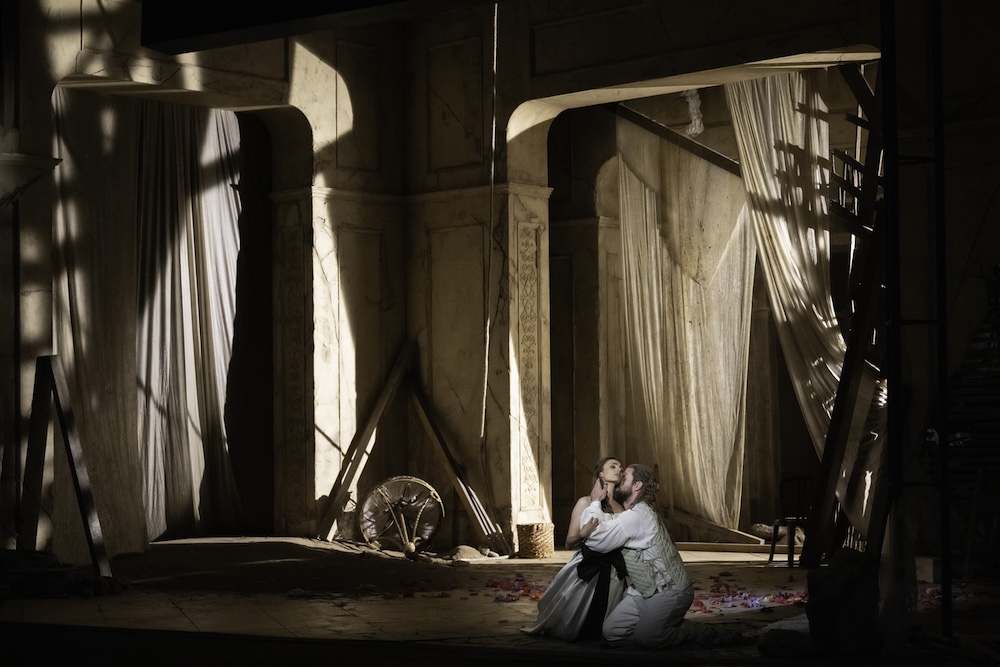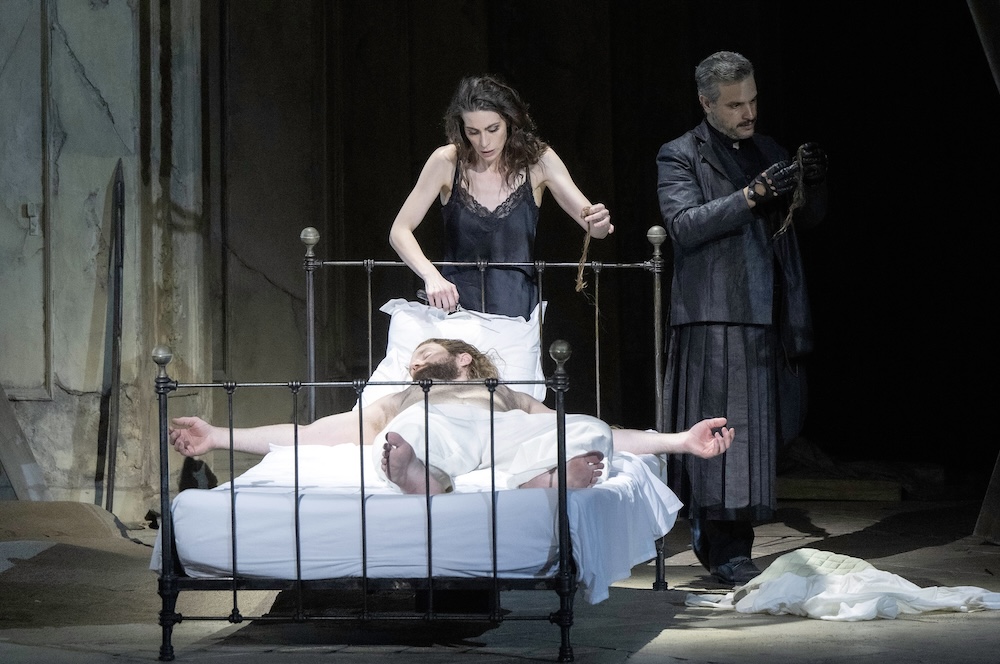Rameau’s Samson, with the libretto by François-Marie Arouet aka Voltaire, or rather a sort of Rameau/Voltaire Samson imagined by French early music conductor Raphaél Pichon and German stage director Otto Guth, a dream team imagined by Aix Festival artistic director Pierre Audi.
Pichon and Guth landed on Rameau’s Samson, an opera that had never been performed though it had been rehearsed, and for which a score no longer exists. Voltaire’s libretto does however exist, but only in a version he created late in life when he no longer wished to be polemical.
While the Samson tale is biblically based, Voltaire had introduced a few tawdry love affairs, and turned Samson’s famed destruction of the Philistine temple into an act of angry desperation, hardly one of religious fervor. The censors found the libretto to be sacrilegious.
As any sensible composer would, Rameau simply re-purposed many pieces from Samson into future operas.
Conductor Pichon with stage director Guth imagined a theatrical action that unfolds quite independently of the published Voltaire libretto, though they maintain that their Samson is well within the spirit of a plausible Voltaire/Rameau Samson, if not the letter. Pichon took on the musical archeology needed to construct a Samson-sounding score, using appropriate bits and pieces of 17 (or so) other operas and ballets by Rameau. These lifted bits cannily approximate the words that might have been uttered by the 1735 Samson singers, the stage actions imposed by the Guth/Pichon production were now those of the Samson story.
The program booklet informs us that messieurs Pichon and Guth felt compelled to include a French Baroque haute-contre voice, given that the original Samson creators took the audacious step of making the opera’s hero a baritone, not the usual tenor. Thus they created the haute-contre role of Elon, Samson’s best friend, who, shocked and horrified at Samson’s impulsive, destructive nature turned Philistine.
While the genesis of this in-the-spirit-of Rameau opera may be fascinating, we are confronted with the actual experience of its performance. Stage director Guth, as he had with his 2022 Aix Festival Dante, il viaggio, felt the need to add a cornice to the opera. For Dante, il viaggio it was a shockingly intrusive, terrifying automobile accident, for Samson it was the addition of a speaking role for Samson’s old mother who spoke the story, with visions of the once young mother, babe-in-arms, and the boy Samson at various ages.

Guth placed the action in a heavily distressed building of neoclassical design, and employed three current architect types to appear from time to time to plot its reconstruction. Thus motivated were the blue laser lights to measure distances that played on the structure from time to time, the vertical red line that swept across the stage from time to time, and the descending bar of intense white light that marked scene closures (falling on Samson in lead photo). To this superimposed light show, Guth added huge electronic sound effects (amplified percussion) when he wished to sonically convey massive, destructive force.
To complete this hyper present, pseudo contemporary stage picture, Guth meticulously costumed his principals in abstracted biblical garb, but reduced his chorus and dancers to abstracted all black dress when they were Philistines and all white dress when they were Israelites. The chorus participated in the action either from the stage in costume or were hidden in the back of the pit, camouflaged in concert blacks.
Such theatrical tricks, among many more as well, beguiled us through this stunning exposition of Rameau’s music for the theater, when the Guth tricks did not irritate us.
Raphaël Pichon is the conductor and artistic force behind the chorus and orchestra ensemble named Pygmalion, based at the Opéra de Bordeaux. For this Baroque opera its choral voices were termed the dessus (soprano), haute-contre (alto tenors), tailles (baritone) and basses, its orchestral players performed on instruments of the French Baroque (though other times its instruments may be of the Classical or Romantic periods). It is an ensemble of exceptional polish and impeccable technique.
Rameau is famed as a symphonist. The Pygmalion orchestra, here comprised of 33 strings, quadruple winds, some brass, continuo and percussion, was capable of both massive force, raging sound and passionate feelings in a huge spectrum of colors. Rameau is equally famed as a composer for harpsichord (a chamber music instrument), explaining the beautifully ornamented intimacy of his arioso recitatives enriched by a rich continuo, these occurring particularly in the first part of the evening.
The compendium of Rameau pieces flowed as a seamless whole, though the first act did not find a dramatic or musical unity. The second part of the evening, with the introduction of Dalila took on an unrelenting brutality interspersed with balletic orchestral movements that took sublime flight as pure music, proving Rameau to be among the pantheon of great French composers.

The Festival d’Aix assembled a superlative cast for this unusual operatic event, singers well able to take and hold the stage, with voices accustomed to the Mozart and Rossini roles on important stages. The Americans Jarrett Ott as Samson and Jacquelyn Stucker as Dalila are refugees from the recent The Exterminating Angel at the Paris Opera, both exhibiting in these Rameau pieces an extraordinary musical intelligence that magnified their presences. Samson’s first act love affair was with the Philistine Timna, sung by French-Italian soprano Lea Desandre. She is of pure voice that beautifully melted into the Rameau ariosos. Argentine bass Nahuel di Pierro sang Achisch, the chief of the Philistines. Of fine voice he is a flashy performer who well embodied the brutal confidence of the Philistines.
Completing the cast were Julie Roset as the one winged Angel who sang the Prologue and British tenor Laurence Kilsby who sang the interpolated role of the turncoat Elon. Aixoise film and TV actress Andréa Ferréol spoke the weirdly amplified role of the mother.
Ursula Kudrna designed the costumes, lighting and video was accomplished by Bertrand Cordero. The choreography for the production’s 12 dancer/acrobats was by Sommer Ulrickson.
Michael Milenski
Théâtre de L’Archevéché, Aix-en-Provence, France. July 15, 2024. All photos copyright Monika Rittershaus, courtesy of the Festival d’Aix.